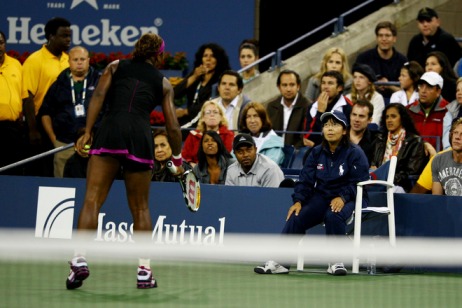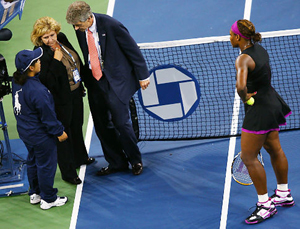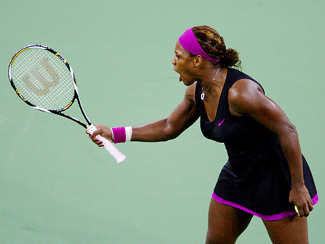Serena Gets
Kid Gloves Treatment
Matt Cronin
About a month after Serena Williams' massive implosion at the US Open, an official from one of the Grand Slam nations told me that there was no chance of the 11-time Grand Slam champion being suspended from one of the 2010 majors, because not one of the events wanted to lose the ticket revenue or high TV ratings that usually come from her appearances. So on November 30, when it was announced that Williams would only be fined $82,500 for her incredible digression in the US Open semifinals against Kim Clijsters, few within the tennis world were surprised. A number of opinion makers, including Mary Carillo, had remarked that a suspension was warranted, but because money talks in such a big way in tennis, Serena was only tagged for 1.4 percent of her record $6,545,586 prize money in 2009.
Williams - who earns about another $8 million per year off court -- was also informed that she's on a two-year probation at the majors, where another so-called major offense could lead to a suspension and an increased fine.
But given the lateness (almost three months after it occurred) and lightness of the verdict this time around, it appears doubtful that Serena will ever be booted out of a tournament, at least as long as she remains a relevant player and a top draw.

|
Did Serena strip this linesperson of her dignity? |
For a game that talks so much about integrity and sportsmanship, the verdict was completely hypocritical. Every Grand Slam nation (the U.S., Britain, France and Australia) has a national federation that sponsors programs where some high ranking official or another will annually preach the value of sportsmanship, decor and fair play to juniors, but when it comes down to practicing what they preach with the game's stars, many top officials are only willing to slap a player on the wrist.
There are those who contend that Serena's behavior at the US Open was a one-off - she physically threatened a linesperson - - but that's not the case. In fact, as charming and endearing as Serena can be, she's admittedly an extremely moody person and can be very confrontational.
Somehow, in rendering its decision, the Grand Slam Committee forgot that at this year's Roland Garros, she threatened Maria Jose Martinez Sanchez after she accused her Spanish opponent of cheating on a controversial point in the first set. Then, she told Martinez: "I'm going to get you in the locker room for that, you don't know me." After she lost the argument with the chair umpire in Paris, she told Martinez, "She better not come to the net again."

|
Why not punish Serena in a way that truly affected her? |
Serena's longtime rival, Daniela Hantuchova, has accused her of purposefully bumping into her during changeovers. Once at the Australian Open, Serena visibly dropped an F-bomb across the net at her opponent, France's Emile Loit.
So if the US Open incident wasn't completely isolated, why not punish Serena in a way that will really affect her, such as fining her say, $1 million dollars or taking away an opportunity for the 28-year-old to win another major and tie one of her heroines, Billie Jean King, with 12 major singles title?
Simply because the game's ruling bodies are willing to sacrifice positive life lessons - which would be that are serious consequences for appalling behavior - for the almighty buck.
There have been comparisons between Williams' outburst and those of four other temperamental ex-players: John McEnroe, Jimmy Connors, Ilie Nastase and Jeff Tarango.
But while all of them could be extremely rude and degrading, none of them ever approached a small lineswoman at a major, shook their racket at her violently and screamed "I swear to God I'm (expletive) going to take this (expletive) ball and shove it down your (expletive) throat, you hear that? I swear to God. You better be...You don't know me..."

|
The first pro player to threaten a linesperson with a racket. |
Mac, Connors and Nastase were certainly more inappropriate on a consistent basis than Serena has been, and without question, all of them should have suffered far more fines and suspensions then they were hit with.
But that doesn't mean that just because officials during the 1970s and 1980 were reticent to throttle their golden gooses that 21st Century tennis leaders should have let off Serena with a relatively small fine.
And what of Tarango, who at 1995 Wimbledon after receiving a bad call actually walked off the court and quit? Later, his wife, Benedicte, slapped chair umpire Bruno Rebeuh in the face. Even though Tarango shouldn't have been held completely accountable for what his now ex-wife did, the Grand Slam committee saw to it to suspend him from the next two Grand Slams and fine him $63,000, including the following year's Wimbledon. Tarango's career earnings are just over $3.3 million (about half of what Serena earned in 2009 alone) and his prize money in 1995 amounted to around $170,000. Therefore, his penalty was much steeper than hers, especially when you consider that for a journeyman player, being forced to miss two Grand Slams also results in severe financial loss, as even if a player falls in the first round of singles and doubles, he still can earn about $30,000 a pop.

|
Bad behavior in the 1980s put fans in the seats, but what kind of precedent did that set? |
"I am thankful that we now have closure on the incident and we can all move forward," said Williams, when the verdict was announced. Last month, when asked about the incident, ITF president Francesco Ricci Bitti said he didn't think that suspending Williams would make much sense "because it would penalize the people handing out the punishment." While that may be the case with the tournaments themselves, who exactly is taking the long-term view and looking out for the integrity of the sport itself?
When the popularity of Connors, McEnroe and Nastase is often discussed, the phrase "great characters" is often used. In many ways, they were. But one of the primary reasons why they put, to use a Connors term, "butts in the seats" is because numerous crossover fans were smitten with their bad boy behavior and were hoping when they attended a match that they would explode, throw a racket, curse out an official, even get on other fans.
In fact, it can be successfully argued that the reason why so many US juniors thought that it was acceptable to throw tantrums during the 1980s was because they saw Johnny Mac do it, had it tolerated, and also won frequently. Anyone who grew up and played as a junior at the time likely now realizes that having another player curse out a volunteer officials at the top of his lungs wasn't exactly doing much for America's future, let alone encouraging bystanders to encourage their kids to take up the sport. The same goes with Serena today: while she is unquestionably the best player of her generation and one of the greatest fighters the sport has ever known, how many parents who saw her strip the US Open lineswoman of her dignity and nearly get off Scot-free are going to want their children to follow in her footpath?
Moreover, how many parents are going to want to place their children in a sport that essentially tolerates such boorish behavior? Probably fewer now than before Serena took the court against Clijsters in September. As Carillo said firmly tongue in cheek when she heard about the fine, "Boy, that ought to show everyone."






